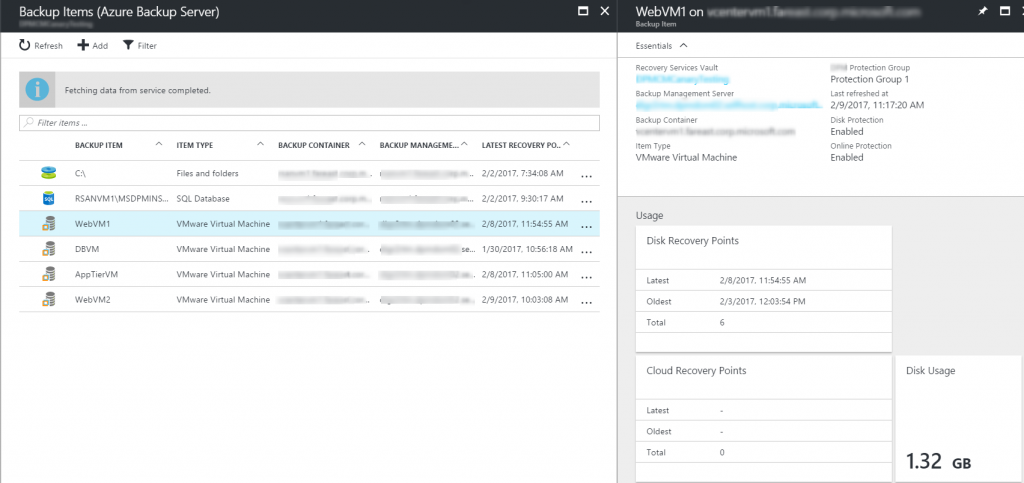Microsoft Azure Backup Server is sporting some nice new features. The tool, available as a free download with Azure Backup, has recently come out with a good deal of features that are worth the extra look–not to mention it’s now available in Canada, the UK, and West US2.
- Central monitoring of backup entities
- Agentless backups
- Securing data against cyber threats and recovery
Microsoft Azure Backup Server benefits
Why use Microsoft Azure Backup Server at all? Simple: other backup solutions have treated the cloud as an endpoint or final destination for storage, but we all know that cloud computing is a lot more vast than that. Azure Backup offers the following benefits:
- Automatic storage management: Azure Backup doesn’t charge you for on-premises storage devices and the cloud offerings are pay-as-you-use. Storage is handled automatically in a hybrid setup.
- Unlimited scaling: The cloud is optimized so that the backups are highly available without maintenance or monitoring overhead. Administrator-enabled alerts can provide more context into issues if any exist.
- Multiple storage options: Azure Backup offers two types of storage replication, locally redundant storage (LRS) which replicates your data three times in a paired datacenter in the same region, and geo-redundant storage (GRS) which replicates your data to a secondary region in a different geography. LRS is a cheaper alternative to GRS but GRS is more durability due to the offsite location being miles away from the original data.
- Unlimited data transfer: There are no limits on inbound or outbound data transfers and Azure Backup does not charge for the transfer of data. (The exception is when you utilize the Azure/Import Export service to import copious amounts of data.)
- Data encryption: Security is key; an encryption passphrase is stored locally (not in Azure).
- Application-consistent backup: Backups are only as strong as their recovery points which have all the required data to restore the backup. With application-consistent backups, no further fixes are needed to recover any backups to its original state without wasting time or causing hassles.
- Long term retention: Azure can be used for both short term and long term retention; it does not limit the length of time you keep your data in a Backup or Recovery Services vault. While it does have a limit of 9999 recovery points per protected instance, you can keep the data for as long as you like (and who is really keeping 9999 recovery points anyway?)
Getting started
Not using Microsoft Azure Backup Server, otherwise known as MABS, just yet? Grab it here for free; you won’t even need System Center or an SQL license for the server DB. Then, watch a few videos on the purpose it serves, how to download it, and how to install and register the tool.
New features
Now that we’ve gone through why Microsoft Azure Backup Server is so useful and how to get started, let’s talk about some new features that make MABS even better.
Central monitoring
It’s now possible to monitor your on-premises assets backed up in Azure Backup Server (not just the assets in the cloud). The Recovery Services vault now provides a centralized view of your backup management servers, protected servers, backup items, and all associations. With central monitoring, you get a holistic view of what the backups look like, enabling you to search, identify Azure Backup Servers that are associated with it, view disk utilization, and whatever else is necessary to properly monitor your backup instances.

Prerequisites: To get started on using central monitoring, you’ll need to complete the following:
- Create a Recovery Services vault
- Download the latest Azure Recovery Services Agent
- Register the Azure Backup Server to this vault you just created
- You also must have Azure Backup Server upgraded to update 1 and need to have the latest Azure Recovery Services Agent (at least version 2.0.9062)
Security features
New security features protect hybrid backups and emphasize the following components:

- Prevention is supported with a new authentication layer, a PIN, that prevents against changing a passphrase or deleting backup data.
- Alerting is supported by email notifications that are sent that may impact availability of backup data, giving users information about possible attacks as soon as they occur.
- Recovery allows for restoration of deleted content; anything that is removed from the backup is retained for 14 days. Additionally, a minimum number of recovery points are always maintained so there are a sufficient number of points to recover from.
Prerequisites:
- Log into your Recovery Services vault and to search for the relevant vault.
- Navigate to Properties under Settings and then click Update under Security Settings.
- Enable “Security Features” in this section.
Agentless backups with VMware support
Azure Backup Server now supports VMware, which means you can support agentless backups, seamless discovery, and auto-protection. This establishes a secure communication channel.
- Agentless backups is enabled because MABS uses VMware’s VADP API to protect VMware VMs remotely without installing agents on vCenter or ESXi servers.
- Seamless discovery and auto-protection is supported through external storage targets such as NFS and cluster storage. VMs are discovered and protected at the folder level, with all new VMs being backed up automatically.
Prerequisites:
- Install a valid certificate on the machine on which the Azure Backup Server is running which will connect to a VMware server
- Download and install Update 1
Azure Backup Server’s new features look to make this a solid solution for those on the cloud (and on-premises too, naturally).
Photo Credit: Shutterstock, Microsoft



